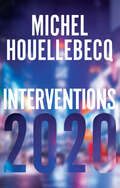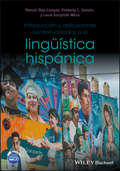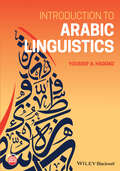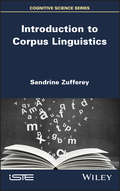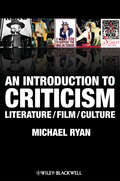- Table View
- List View
Intercultural Language Teaching and Learning
by Anthony J. Liddicoat Angela ScarinoThis wide-ranging survey of issues in intercultural language teaching and learning covers everything from core concepts to program evaluation, and advocates a fluid, responsive approach to teaching language that reflects its central role in fostering intercultural understanding. Includes coverage of theoretical issues defining language, culture, and communication, as well as practice-driven issues such as classroom interactions, technologies, programs, and language assessment Examines systematically the components of language teaching: language itself, meaning, culture, learning, communicating, and assessments, and puts them in social and cultural context Features numerous examples throughout, drawn from various languages, international contexts, and frameworks Incorporates a decade of in-depth research and detailed documentation from the authors’ collaborative work with practicing teachers Provides a much-needed addition to the sparse literature on intercultural aspects of language education
Internal Colonization: Russia's Imperial Experience
by Alexander EtkindThis book gives a radically new reading of Russia’s cultural history. Alexander Etkind traces how the Russian Empire conquered foreign territories and domesticated its own heartlands, thereby colonizing many peoples, Russians included. This vision of colonization as simultaneously internal and external, colonizing one’s own people as well as others, is crucial for scholars of empire, colonialism and globalization. Starting with the fur trade, which shaped its enormous territory, and ending with Russia’s collapse in 1917, Etkind explores serfdom, the peasant commune, and other institutions of internal colonization. His account brings out the formative role of foreign colonies in Russia, the self-colonizing discourse of Russian classical historiography, and the revolutionary leaders’ illusory hopes for an alliance with the exotic, pacifist sectarians. Transcending the boundaries between history and literature, Etkind examines striking writings about Russia’s imperial experience, from Defoe to Tolstoy and from Gogol to Conrad. This path-breaking book blends together historical, theoretical and literary analysis in a highly original way. It will be essential reading for students of Russian history and literature and for anyone interested in the literary and cultural aspects of colonization and its aftermath.
Internal Colonization: Russia's Imperial Experience
by Alexander EtkindThis book gives a radically new reading of Russia’s cultural history. Alexander Etkind traces how the Russian Empire conquered foreign territories and domesticated its own heartlands, thereby colonizing many peoples, Russians included. This vision of colonization as simultaneously internal and external, colonizing one’s own people as well as others, is crucial for scholars of empire, colonialism and globalization. Starting with the fur trade, which shaped its enormous territory, and ending with Russia’s collapse in 1917, Etkind explores serfdom, the peasant commune, and other institutions of internal colonization. His account brings out the formative role of foreign colonies in Russia, the self-colonizing discourse of Russian classical historiography, and the revolutionary leaders’ illusory hopes for an alliance with the exotic, pacifist sectarians. Transcending the boundaries between history and literature, Etkind examines striking writings about Russia’s imperial experience, from Defoe to Tolstoy and from Gogol to Conrad. This path-breaking book blends together historical, theoretical and literary analysis in a highly original way. It will be essential reading for students of Russian history and literature and for anyone interested in the literary and cultural aspects of colonization and its aftermath.
International Handbook of Research on Children's Literacy, Learning and Culture
by Kathy Hall Teresa Cremin Barbara Comber Luis C. MollThe International Handbook of Research in Children's Literacy, Learning and Culture presents an authoritative distillation of current global knowledge related to the field of primary years literacy studies. Features chapters that conceptualize, interpret, and synthesize relevant research Critically reviews past and current research in order to influence future directions in the field of literacy Offers literacy scholars an international perspective that recognizes and anticipates increasing diversity in literacy practices and cultures
International Handbook of Research on Children's Literacy, Learning and Culture
by Barbara ComberThe International Handbook of Research in Children's Literacy, Learning and Culture presents an authoritative distillation of current global knowledge related to the field of primary years literacy studies. Features chapters that conceptualize, interpret, and synthesize relevant research Critically reviews past and current research in order to influence future directions in the field of literacy Offers literacy scholars an international perspective that recognizes and anticipates increasing diversity in literacy practices and cultures
International News Reporting: Frontlines and Deadlines
by John Owen Heather PurdeyA collection of essays by top international correspondants in print, broadcasting, and photojournalism, International News Reporting offers an introduction to journalism written by the people who have made the profession what it is today. Contributors identify the major areas of professional practice which students and young journalists need to know in order to work safely in, and understand fully, the field of international news gathering Looks at events from conflicts to humanitarian disasters Covers crucial topics such as how to report stories about the developing world, how to avoid stereotyping, the uses and abuses of blogging, and risk assessment for journalists in conflict zones
International Virtual Teams: Engineering Global Success (IEEE PCS Professional Engineering Communication Series)
by Pam Estes BrewerDr. Brewer presents a complete guide to international virtual team communication with the most up-to-date research developments in the engineering workplace on a global scale, and a problem-solving approach to using and communicating in virtual teams. Presents guidelines heavily based on empirical data Application of virtual team communication guidelines to the field of engineering Provides strategies and sample projects for teaching
International Virtual Teams: Engineering Global Success (IEEE PCS Professional Engineering Communication Series)
by Pam Estes BrewerDr. Brewer presents a complete guide to international virtual team communication with the most up-to-date research developments in the engineering workplace on a global scale, and a problem-solving approach to using and communicating in virtual teams. Presents guidelines heavily based on empirical data Application of virtual team communication guidelines to the field of engineering Provides strategies and sample projects for teaching
Interventions 2020
by Michel HouellebecqThe death of God in the West was the prelude to a formidable metaphysical soap opera that continues to this day. Christianity’s masterstroke was to combine a fierce belief in the individual with the promise of eternal participation in the Absolute. When that dream evaporated, various attempts were made to offer the individual a minimum of being. The latest of these attempts is advertising, which seeks to arouse desire and transform the subject into a docile phantom doomed to follow advertising’s every whim. But, like all previous attempts, this skin-deep, superficial participation in the world fails, and unhappiness and depression continue to spread.However, we can all produce a cold revolution in ourselves by stepping outside the flow of information and advertising. We need to take some time out, unplug the television, turn off our iPhones, stop buying stuff, stop wanting to buy stuff, temporarily detach ourselves and adopt an aesthetic attitude to the world. We just need to stay still for a few seconds.This is one of the key themes developed by Michel Houellebecq in this collection of his texts and interviews from the last three decades. Here he explains and elaborates his point of view, discusses his novels and addresses a wide range of topics from politics, religion and literature to suicide, euthanasia and paedophilia. An indispensable book for anyone interested in the work of one of the most widely read and controversial novelists of our time.
Introducción a la sociolingüística hispánica
by Manuel Diaz-CamposIntroducción a la Sociolingüística Hispánica es un libro de texto imprescindible para los estudiantes de pregrado que cursan sociolingüística hispánica. Cada capítulo está redactado en un lenguaje sencillo y accesible. Sobre la base de un enfoque pedagógico, cada capítulo incluye una introducción, una lista de los temas a ser discutidos, el desarrollo de tales temas, un resumen, una lista de términos claves, un glosario de la terminología clave, una sección de ejercicios y preguntas de comprensión al final de cada sección temática de cada capítulo. Provee una introducción actualizada sobre los temas más relevantes de la versátil sociolingüística española contemporánea tales como la variación fonológica, el bilingüismo, la lengua y las leyes, las actitudes lingüísticas, entre otros Incluye una variedad de actividades para apoyar y extender el aprendizaje de los estudiantes Ofrece un enfoque pedagógico único que incluye ejercicios de análisis de datos. Estas actividades estimulan la investigación por parte de los estudiantes a través del uso de las bases de datos, la música popular y otros recursos audiovisuales El libro incluye ejemplos de las variedades de español habladas en el mundo hispanohablante con secciones especiales dedicadas a las variedades habladas en los EEUU Introducción a la Sociolingüística Hispánica is a much-needed undergraduate introduction to the study of sociolinguistics in the Spanish-speaking world. Written in accessible Spanish, each chapter includes an overview, a review of topics, a section of key terms, exercises and questions. Provides up-to-date coverage of the main topics of sociolinguistics – such as phonological variation, bilingualism, and language attitudes – in relation to the Hispanic world Incorporates a variety of activities to support and extend student’s learning Offers a unique pedagogical approach, in which data analysis exercises encourage students to conduct research by using electronic databases, popular music, and audiovisual material Features examples that apply to Spanish varieties spoken around the world, with special sections dedicated to the Spanish varieties of the US
Introducción a la sociolingüística hispánica
by Manuel Diaz-CamposIntroducción a la Sociolingüística Hispánica es un libro de texto imprescindible para los estudiantes de pregrado que cursan sociolingüística hispánica. Cada capítulo está redactado en un lenguaje sencillo y accesible. Sobre la base de un enfoque pedagógico, cada capítulo incluye una introducción, una lista de los temas a ser discutidos, el desarrollo de tales temas, un resumen, una lista de términos claves, un glosario de la terminología clave, una sección de ejercicios y preguntas de comprensión al final de cada sección temática de cada capítulo. Provee una introducción actualizada sobre los temas más relevantes de la versátil sociolingüística española contemporánea tales como la variación fonológica, el bilingüismo, la lengua y las leyes, las actitudes lingüísticas, entre otros Incluye una variedad de actividades para apoyar y extender el aprendizaje de los estudiantes Ofrece un enfoque pedagógico único que incluye ejercicios de análisis de datos. Estas actividades estimulan la investigación por parte de los estudiantes a través del uso de las bases de datos, la música popular y otros recursos audiovisuales El libro incluye ejemplos de las variedades de español habladas en el mundo hispanohablante con secciones especiales dedicadas a las variedades habladas en los EEUU Introducción a la Sociolingüística Hispánica is a much-needed undergraduate introduction to the study of sociolinguistics in the Spanish-speaking world. Written in accessible Spanish, each chapter includes an overview, a review of topics, a section of key terms, exercises and questions. Provides up-to-date coverage of the main topics of sociolinguistics – such as phonological variation, bilingualism, and language attitudes – in relation to the Hispanic world Incorporates a variety of activities to support and extend student’s learning Offers a unique pedagogical approach, in which data analysis exercises encourage students to conduct research by using electronic databases, popular music, and audiovisual material Features examples that apply to Spanish varieties spoken around the world, with special sections dedicated to the Spanish varieties of the US
Introducción y aplicaciones contextualizadas a la lingüística hispánica
by Kimberly L. Geeslin Manuel Diaz-Campos Laura Gurzynski-WeissIntroducción y aplicaciones contextualizadas a la lingüística hispánica provides a contemporary introduction to the study of Spanish, helping students apply linguistics analysis to the study of language. It encourages the reader to analyze language in action and understand how linguistic components interact to convey conceptual and social meaning. A contemporary introduction to the study of Spanish that encourages both Spanish and semi-proficient non-native Spanish speaking students to see language in action and understand how linguistic components interact to convey conceptual and social meaning Addresses the core sub-fields of linguistics (phonetics, phonology, morphology, syntax, semantics, and pragmatics) as they relate to the study of the Spanish language Uses second language acquisition as a foundation upon which linguistic analysis can be built Supplementary companion website includes exercises, comprehension questions, cutting-edge research highlights, lists of key terms, and analytical mini-projects designed to help the user and encourage students to apply learned theoretical knowledge to real-world language use contexts Instructors will also have access to a sample 16-week semester syllabus and corresponding task-based lesson plans (in PowerPoint format) as well as assignments which they can edit for use in their own learning context.
Introducción y aplicaciones contextualizadas a la lingüística hispánica
by Kimberly L. Geeslin Manuel Diaz-Campos Laura Gurzynski-WeissIntroducción y aplicaciones contextualizadas a la lingüística hispánica provides a contemporary introduction to the study of Spanish, helping students apply linguistics analysis to the study of language. It encourages the reader to analyze language in action and understand how linguistic components interact to convey conceptual and social meaning. A contemporary introduction to the study of Spanish that encourages both Spanish and semi-proficient non-native Spanish speaking students to see language in action and understand how linguistic components interact to convey conceptual and social meaning Addresses the core sub-fields of linguistics (phonetics, phonology, morphology, syntax, semantics, and pragmatics) as they relate to the study of the Spanish language Uses second language acquisition as a foundation upon which linguistic analysis can be built Supplementary companion website includes exercises, comprehension questions, cutting-edge research highlights, lists of key terms, and analytical mini-projects designed to help the user and encourage students to apply learned theoretical knowledge to real-world language use contexts Instructors will also have access to a sample 16-week semester syllabus and corresponding task-based lesson plans (in PowerPoint format) as well as assignments which they can edit for use in their own learning context.
Introducing Second Language Acquisition: Perspectives and Practices (Linguistics in the World)
by Kirsten M. HummelIntroducing Second Language Acquisition: Perspectives and Practices represents a clear and concise introduction to the main concepts, issues, and debates in second language acquisition studies aimed specifically at undergraduates encountering the topic for the first time. Follows six fictitious language learners throughout the text whose stories serve to introduce various concepts and issues Contains specific chapters on first language acquisition and bilingualism, as well as explicit references to the most recent and important research Covers key topics including acquisition contexts, theoretical perspectives, language teaching methods, second language development, and individual differences (such as age, aptitude, and motivation) Grabs student attention with lighthearted cartoons that illustrate and reinforce key ideas Features a full range of pedagogical tools to aid student learning, including “language learning in practice” textboxes; bolded new terms defined in the margins; an end-of-book glossary; self-assessment and classroom discussion questions; exercise and project ideas; and further online viewing sections
Introducing Second Language Acquisition: Perspectives and Practices (Linguistics in the World)
by Kirsten M. HummelIntroducing Second Language Acquisition: Perspectives and Practices represents a clear and concise introduction to the main concepts, issues, and debates in second language acquisition studies aimed specifically at undergraduates encountering the topic for the first time. Follows six fictitious language learners throughout the text whose stories serve to introduce various concepts and issues Contains specific chapters on first language acquisition and bilingualism, as well as explicit references to the most recent and important research Covers key topics including acquisition contexts, theoretical perspectives, language teaching methods, second language development, and individual differences (such as age, aptitude, and motivation) Grabs student attention with lighthearted cartoons that illustrate and reinforce key ideas Features a full range of pedagogical tools to aid student learning, including “language learning in practice” textboxes; bolded new terms defined in the margins; an end-of-book glossary; self-assessment and classroom discussion questions; exercise and project ideas; and further online viewing sections
Introducing Second Language Acquisition: Perspectives and Practices (Linguistics in the World)
by Kirsten M. HummelAn up-to-date overview of second language acquisition, designed to engage 21st-century learners Introducing Second Language Acquisition: Perspectives and Practices provides a clear and comprehensive introduction to the main concepts, issues, and debates in second language acquisition studies. This introductory textbook is aimed specifically at students encountering the topic for the first time. Each chapter offers a modern layout with engaging pedagogical features such as self-assessment and discussion questions, project ideas, and further reading and viewing suggestions. The second edition of Introducing Second Language Acquisition: Perspectives and Practices has been fully updated to reflect the most recent scholarship in the field. It introduces a new structure, featuring separate chapters on theoretical perspectives which cover past and present approaches as well as cognitive approaches. New content also includes sections on skill acquisition theory, translanguaging, second language literacy development, and multilingualism. Written in accessible language and with a focus on practical applications, this go-to textbook is a clear and concise introduction to second language acquisition studies, offering lessons drawn from the latest leading research. It is an ideal resource for students in applied linguistics and second language education. This key text offers: Comprehensive coverage of the latest research in second language acquisition studies Improved organizational structure to promote greater student comprehension Engaging introduction to the theoretical underpinnings of second language acquisition, with chapters on first language acquisition and bilingualism and multilingualism Coverage of key topics including acquisition contexts, theoretical perspectives, language teaching methods, and individual differences Pedagogical tools to aid student learning, including “language learning in practice” textboxes, bolded terms defined in the margins, and an end-of-book glossary With a strong focus on the fundamentals, this second edition of Introducing Second Language Acquisition stands as an innovative guide. This book is ideal for today’s undergraduate students, offering a practical focus and appealing format that will aid in learning and provide a solid foundation for further study.
Introducing Second Language Acquisition: Perspectives and Practices (Linguistics in the World)
by Kirsten M. HummelAn up-to-date overview of second language acquisition, designed to engage 21st-century learners Introducing Second Language Acquisition: Perspectives and Practices provides a clear and comprehensive introduction to the main concepts, issues, and debates in second language acquisition studies. This introductory textbook is aimed specifically at students encountering the topic for the first time. Each chapter offers a modern layout with engaging pedagogical features such as self-assessment and discussion questions, project ideas, and further reading and viewing suggestions. The second edition of Introducing Second Language Acquisition: Perspectives and Practices has been fully updated to reflect the most recent scholarship in the field. It introduces a new structure, featuring separate chapters on theoretical perspectives which cover past and present approaches as well as cognitive approaches. New content also includes sections on skill acquisition theory, translanguaging, second language literacy development, and multilingualism. Written in accessible language and with a focus on practical applications, this go-to textbook is a clear and concise introduction to second language acquisition studies, offering lessons drawn from the latest leading research. It is an ideal resource for students in applied linguistics and second language education. This key text offers: Comprehensive coverage of the latest research in second language acquisition studies Improved organizational structure to promote greater student comprehension Engaging introduction to the theoretical underpinnings of second language acquisition, with chapters on first language acquisition and bilingualism and multilingualism Coverage of key topics including acquisition contexts, theoretical perspectives, language teaching methods, and individual differences Pedagogical tools to aid student learning, including “language learning in practice” textboxes, bolded terms defined in the margins, and an end-of-book glossary With a strong focus on the fundamentals, this second edition of Introducing Second Language Acquisition stands as an innovative guide. This book is ideal for today’s undergraduate students, offering a practical focus and appealing format that will aid in learning and provide a solid foundation for further study.
Introduction to Arabic Linguistics
by Youssef A. HaddadA comprehensive introduction to the linguistic fundamentals of modern Arabic, ideal for Arabic language learners as well as speakers interested in developing a richer understanding of language use and behavior Introduction to Arabic Linguistics presents a clear and engaging overview of the core linguistic aspects of modern Arabic, focusing on Modern Standard Arabic and Levantine Arabic. Designed to be welcoming for undergraduates without fluency in Arabic and for students with only limited familiarity with linguistics, this textbook covers all fundamental areas of Arabic linguistics. Detailed yet accessible chapters include comprehension and analysis questions, critical thinking exercises, application examples with authentic data, reading assignments, and classroom and homework projects. This valuable textbook is organized into three units which cover sounds and sound systems, word structure and meaning, and phrases and phrase structure. Author Youssef Haddad draws from both the Arabic grammatical tradition and recent linguistic research to provide students with a solid foundation in the linguistic features and structures of Arabic sounds, words, and phrases. Topics include phonological processes, derivational morphology, noun and verb phrases, sentence structure, structural ambiguity, and more. Discusses key topics in the formal study of Arabic linguistics, suitable for Arabic speakers and language learners Encourages students to investigate a dialect not covered in the book at different levels of linguistic analysis Answers many of the most common and relevant questions in the field of Arabic linguistics Includes a typological and historical overview of the Arabic language Offers an instructor’s website with additional exercises, practice questions, PowerPoint presentations, and answer keysIntroduction to Arabic Linguistics is the perfect textbook for undergraduates in modern language and linguistic courses and a valuable resource for graduate students in Arabic studies or linguistics programs.
Introduction to Arabic Linguistics
by Youssef A. HaddadA comprehensive introduction to the linguistic fundamentals of modern Arabic, ideal for Arabic language learners as well as speakers interested in developing a richer understanding of language use and behavior Introduction to Arabic Linguistics presents a clear and engaging overview of the core linguistic aspects of modern Arabic, focusing on Modern Standard Arabic and Levantine Arabic. Designed to be welcoming for undergraduates without fluency in Arabic and for students with only limited familiarity with linguistics, this textbook covers all fundamental areas of Arabic linguistics. Detailed yet accessible chapters include comprehension and analysis questions, critical thinking exercises, application examples with authentic data, reading assignments, and classroom and homework projects. This valuable textbook is organized into three units which cover sounds and sound systems, word structure and meaning, and phrases and phrase structure. Author Youssef Haddad draws from both the Arabic grammatical tradition and recent linguistic research to provide students with a solid foundation in the linguistic features and structures of Arabic sounds, words, and phrases. Topics include phonological processes, derivational morphology, noun and verb phrases, sentence structure, structural ambiguity, and more. Discusses key topics in the formal study of Arabic linguistics, suitable for Arabic speakers and language learners Encourages students to investigate a dialect not covered in the book at different levels of linguistic analysis Answers many of the most common and relevant questions in the field of Arabic linguistics Includes a typological and historical overview of the Arabic language Offers an instructor’s website with additional exercises, practice questions, PowerPoint presentations, and answer keysIntroduction to Arabic Linguistics is the perfect textbook for undergraduates in modern language and linguistic courses and a valuable resource for graduate students in Arabic studies or linguistics programs.
Introduction to Corpus Linguistics
by Sandrine ZuffereyOver the past decades, the use of quantitative methods has become almost generalized in all domains of linguistics. However, using these methods requires a thorough understanding of the principles underlying them. Introduction to quantitative methods in linguistics aims at providing students with an up-to-date and accessible guide to both corpus linguistics and experimental linguistics. The objectives are to help students developing critical thinking about the way these methods are used in the literature and helping them to devise their own research projects using quantitative data analysis.
Introduction to Corpus Linguistics
by Sandrine ZuffereyOver the past decades, the use of quantitative methods has become almost generalized in all domains of linguistics. However, using these methods requires a thorough understanding of the principles underlying them. Introduction to quantitative methods in linguistics aims at providing students with an up-to-date and accessible guide to both corpus linguistics and experimental linguistics. The objectives are to help students developing critical thinking about the way these methods are used in the literature and helping them to devise their own research projects using quantitative data analysis.
An Introduction to Criticism: Literature - Film - Culture (Coursesmart Ser.)
by Michael RyanAn accessible and thorough introduction to literary theory and contemporary critical practice, this book is an essential resource for beginning students of literary criticism. Covers traditional approaches such as formalism and structuralism, as well as more recent developments in criticism such as evolutionary theory, cognitive studies, ethical criticism, and ecocriticism Offers explanations of key works and major ideas in literary criticism and suggests key elements to look for in a literary text Also applies critical approaches to various examples from film studies Helps students to build a critical framework and write analytically
An Introduction to Criticism: Literature - Film - Culture
by Michael RyanAn accessible and thorough introduction to literary theory and contemporary critical practice, this book is an essential resource for beginning students of literary criticism. Covers traditional approaches such as formalism and structuralism, as well as more recent developments in criticism such as evolutionary theory, cognitive studies, ethical criticism, and ecocriticism Offers explanations of key works and major ideas in literary criticism and suggests key elements to look for in a literary text Also applies critical approaches to various examples from film studies Helps students to build a critical framework and write analytically
Introduction to Experimental Linguistics
by Christelle Gillioz Sandrine ZuffereyThe use of experimental methodology in the field of linguistics has boomed in recent decades. However, implementation of such methods does require an understanding and mastery of specific theoretical and methodological principles. Introduction to Experimental Linguistics presents the key concepts of experimental linguistics in an accessible way, addressing, in turn: the application of experimentation in linguistics; the techniques most frequently used for the study of language; the methodological and practical aspects useful for the implementation of an experiment; and an introduction to the analysis of quantitative data derived from experiments. This didactic book combines the elements presented with examples drawn from the various fields of linguistics. It also includes a number of resources available for people who wish to implement an experimental study, more advanced reading suggestions, and revision questions along with their answer key.
Introduction to Experimental Linguistics
by Christelle Gillioz Sandrine ZuffereyThe use of experimental methodology in the field of linguistics has boomed in recent decades. However, implementation of such methods does require an understanding and mastery of specific theoretical and methodological principles. Introduction to Experimental Linguistics presents the key concepts of experimental linguistics in an accessible way, addressing, in turn: the application of experimentation in linguistics; the techniques most frequently used for the study of language; the methodological and practical aspects useful for the implementation of an experiment; and an introduction to the analysis of quantitative data derived from experiments. This didactic book combines the elements presented with examples drawn from the various fields of linguistics. It also includes a number of resources available for people who wish to implement an experimental study, more advanced reading suggestions, and revision questions along with their answer key.





